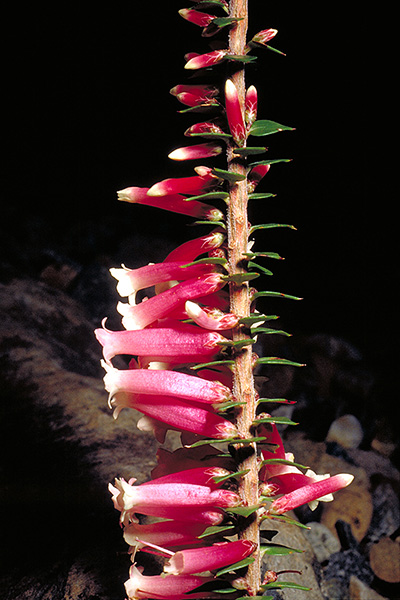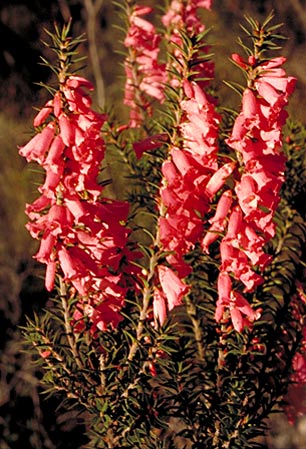|
[Front Page] [Features] [Departments] [Society Home] [Subscribe]

Epacrids from Cuttings
Ross Doig
Members of the Epacris family (Epacridaceae) have generally been considered very difficult to propagate from both seed and cuttings. Problems with collection of seed, the fiddly nature of dealing with such fine seed and difficulties in potting on tiny seedlings with fine, hair roots have led me to eschew seeds in favour of cuttings. Before detailing results with individual species a brief description of the three systems I have used (under Sydney conditions) for propagating cuttings follows.
System 1
In this method, two large foam fruit boxes are selected and the undulating tops cut off squarely. They are then glued together (one box being turned upside down) and, when bonded, a slanting cut is made from back to front giving a height of approx 390mm at the rear and 230mm at the front (original boxes approx 570mm by 380mm).
Semi rigid plastic (laminating plastic) is then used to cover the slanting top. The four edges are crimped down to overlap each side to a depth of 6cm. Glass or rigid clear plastic may be used as an alternative, depending on the user's preference.
Cuttings are placed in 50 x 70mm tubes using washed river sand or crushed sandstone from 2mm size down to just above silt size and tubes are placed directly on the box base.
Each cutting averages between 80mm and 250mm selected from growing tips or side shoots and leaves are left up to half the length of the cutting. Yellow "Induce" or Yates Hormone Powder is used and usually 6 cuttings per tube firmed in with a flat knitting needle end and watered thoroughly.
The foam box is kept permanently in semi-shade with minimal morning sun.
 |
Epacris longiflora is a common sight in sheltered, moist sites around Sydney.
Select the thumbnail image or highlighted name for a higher resolution image (19k).
|
System 2
For the second system, the boxes in system 1 are placed in a dry, plastic walled, fiberglass roofed shadehouse, with a door and a louvre at each end for ventilation. A shadecloth blind is used over the roof in the heat of summer.
Watering of cuttings is done individually, with minimum wetting of leaves and spraying of cuttings once a day when air temperature rises to 27 oC and above.
 |  |
Styphelia laeta (left) and Sprengelia incarnata (right) are two very attractive small epacrids which are rarely seen in cultivation.
Select the thumbnail image or highlighted name for a higher resolution image (30k and 34k).
|
System 3
In this system a capillary bed is constructed from a foam box as used in system 1. However this box is waterproof (broccoli and prawn boxes have no holes) and will hold moisture in the bed of sand to 35mm depth in the base of the box.
A plastic drink bottle about 1.25 litre capacity is filled with water, inverted and embedded into the sand bed. One method of doing this is to bend stiff wire mesh into a "U" shape with a hole in its centre and secure the neck of the bottle into the hole (see diagram).
Cuttings are prepared as for system 1 in 50 x 70mm tubes and placed on the moist sand under a PET bottles. Three tubes fit under each bottle which have their bases cut out and the caps discarded. Eleven bottles with 33 tubes as well as the water bottle fit within the foam box. The box is placed in a glasshouse, bush house, igloo, cold frame or morning sun position on a verandah. Watering is by refilling the bottle and intervals will vary from 5 to 15 days according to the season.
Without heat or misting, the system is maintained over the whole year and, apart from rooting time slowing up in June, July and August, no ill-effects from temperatures down to 9oC have been noticed.

Results
Using these methods, the following Epacridaceae have struck in the holding period of between six and twelve months:
- Acrotriche divaricata
- Astroloma pinifolium, humifusum
- Epacris Iongiflora, pulchella. purpurascens, microphylla, crassifolia. obtusifolia
- Leucopogon microphylla amplexicaulis, lanceolata. setiger, ericoides, virgatus
- Lissanthe strigosa
- Melichrus procumbens
- Monotoca elliptica, scoparia
- Sprengelia incarnata
- Styphelia. tubiflora, laeta, longifolia, triflora, viridis
- Woolsia pungens
|

The common heath, Epacris impressa, is Victoria's floral emblem. It can also be found in a range of colours from white through to deep red.
Select the thumbnail image or highlighted name for a higher resolution image (39k).
|
Failures have been Epacris muelleri and E.rigida, Dracophyllum secundum and Lissanthe sapida.
Most of the above have been tried once or twice and opportunity for further trial has so far been impossible. As a result of experience with epacrids the following observations can be made.
- It is possible to take cuttings at any time of the year, to hold them for a year, or longer and with a "cold, non-misting system" to achieve at least 30% strikes.
- With suitable half hardened wood, long cuttings of up to 300mm and cuttings with terminal shoots can be utilised.
- Hormone powders of medium strength are suitable, if not absolutely necessary.
- In potting on, care must be taken as roots of most of this family are fine, in fact, hair-like. Either retain as much cutting medium around the roots as possible or ensure that they are spread out. Roots clumped against the stem will cause the plant to die promptly. This applies to all species of this family that I have tried.
- Bush sand with leaf mould mixed in and a small amount of sandy clay (tennis loam) to supply iron is an ideal potting mix. Osmocote native plant slow release pellets provide extra food.
- After potting up, newly struck cuttings are staged in a foam box with loose cover for two weeks, then placed on an open bench for a further two weeks. They are then put (closely packed) in foam boxes in semi shade until planted out.
- In general, species of this family make slow top and root growth and can be held in the nursery for up to two years. 100mm and 150mm tumblers and square tubes are therefore suitable for plants up 30cm high.
Considering the beauty of many of this family and the long flowering period of some, propagation from cuttings is worthwhile with the added bonus of flowering in the first season in the ground or pots as opposed to at least two seasons to flower from seed.
 |
The flowers and foliage of Dracophyllum secundum make it a very desirable plant for cultivation. Propagation, however, is unreliable.
Select the thumbnail image or highlighted name for a higher resolution image (30k).
|
Reprinted from the September 1999 issue of the Newsletter of the Australian Plants Society (Victoria).

[Front Page] [Features] [Departments] [Society Home] [Subscribe]
Australian Plants online - December 1999
Association of Societies for Growing Australian Plants
|